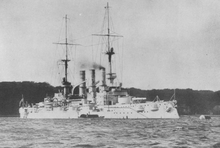SMS Pommern
Named after the Prussian province of Pomerania, she was built at the AG Vulcan yard at Stettin, Germany (now Szczecin, Poland), where she was laid down on 22 March 1904 and launched on 2 December 1905.
The ships of her class were already outdated by the time they entered the service, being inferior in size, armor, firepower, and speed to the revolutionary new battleship HMS Dreadnought.
After commissioning, Pommern was assigned to II Battle Squadron of the High Seas Fleet, where she served throughout her peacetime career and the first two years of World War I.
At the start of the war, Pommern and the rest of II Battle Squadron were tasked with supporting the defenses of the German Bight, and were stationed at the mouth of the Elbe.
During the confused night actions in the early hours of 1 June, she was hit by one, or possibly two, torpedoes from the British destroyer HMS Onslaught, which detonated one of Pommern's 17-centimeter (6.7 in) gun magazines.
The passage of the Second Naval Law in 1900 under the direction of Vizeadmiral (VAdm—Vice Admiral) Alfred von Tirpitz secured funding for the construction of twenty new battleships over the next seventeen years.
Her armored belt was 240 millimeters (9.4 in) thick in the central portion, where it protected her magazines and machinery spaces, while thinner plating covered the ends of the hull.
[11] She was commissioned for sea trials on 6 August; during her speed run, she reached 19.26 knots (35.67 km/h; 22.16 mph), which made her the fastest pre-dreadnought battleship in the world.
[12] Pommern was assigned to II Battle Squadron of the High Seas Fleet alongside her sisters, replacing the battleship Kurfürst Friedrich Wilhelm, though she was not fully ready for active duty until 11 November.
Prince Heinrich had pressed for such a cruise the previous year, arguing that it would prepare the fleet for overseas operations and would break up the monotony of training in German waters, though tensions with Britain over the developing Anglo-German naval arms race were high.
Another cruise into the Atlantic was conducted from 7 July to 1 August, and while on the way back to Germany, the High Seas Fleet was received by the British Royal Navy in Spithead.
His tenure as fleet commander was marked by strategic experimentation, owing to the increased threat the latest underwater weapons posed, and because the new Nassau-class battleships were too wide to pass through the Kaiser Wilhelm Canal.
Another fleet review was held during the exercises for a visiting Austro-Hungarian delegation that included Archduke Franz Ferdinand and Admiral Rudolf Montecuccoli.
In mid-1912, due to the Agadir Crisis, the summer cruise only went into the Baltic to avoid exposing the fleet during the period of heightened tension with Britain and France.
[13] In July 1914, about two weeks after the assassination of Archduke Franz Ferdinand in Sarajevo, Pommern was with the High Seas Fleet during its annual summer cruise to Norway.
[22] Pommern and the rest of II Battle Squadron then rejoined the High Seas Fleet as part of the battleship support for the battlecruisers in I Scouting Group that bombarded Scarborough, Hartlepool, and Whitby on 15–16 December 1914.
[23] The main fleet acted as distant support for Konteradmiral (KAdm—Rear Admiral) Franz von Hipper's battlecruiser squadron while it raided the coastal towns.
Under orders from Wilhelm II to avoid battle if victory was not certain, Ingenohl broke off the engagement and turned the battlefleet back towards Germany.
[23] On 24–25 April 1916, Pommern and her sisters joined the dreadnoughts of the High Seas Fleet to support the battlecruisers, which were again tasked with conducting a raid of the English coast.
[28] Pommern remained assigned to II Battle Squadron, which was positioned at the rear of the German line and under the command of KAdm Franz Mauve [de].
Mauve considered moving his ships to the rear of the line, astern of III Battle Squadron dreadnoughts, but decided against it when he realized the movement would interfere with the maneuvering of Hipper's battlecruisers.
[37] The British battlecruisers scored several hits on the German ships, including one on Pommern by a 12-inch (30.5 cm) shell fired by Indomitable,[38] forcing her to haul out of line.



